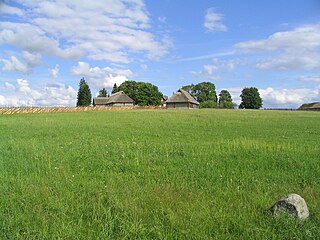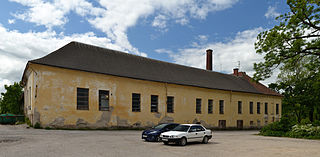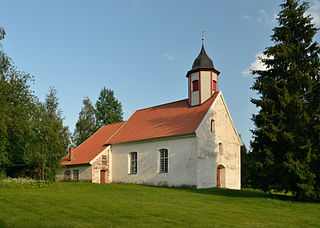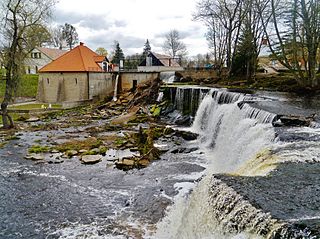Related Research Articles

Estonian is a Finnic language of the Uralic family. Estonian is the official language of Estonia. It is written in the Latin script and is the first language of the majority of the country's population; it is also an official language of the European Union. Estonian is spoken natively by about 1.1 million people: 922,000 people in Estonia and 160,000 elsewhere.

Järva County is one of 15 counties of Estonia. It is situated in the central part of the country and borders Lääne-Viru County to the east, Jõgeva County to the south-east, Viljandi County to the south, Pärnu County to the south-west, Rapla County to the west, and Harju County to the north. In January 2009, Järva County had a population of 29,940 – constituting 2.7% of the total population in Estonia.

Saare County is one of 15 counties of Estonia. It consists of Saaremaa, the largest island of Estonia, and several smaller islands near it, most notably Muhu, Ruhnu, Abruka and Vilsandi. The county borders Lääne County to the east, Hiiu County to the north, and Latvia to the south. In 2022, Saare County had a population of 31,292, which was 2.4% of the population of Estonia.

Setos are an indigenous Finnic peoples and linguistic minority that have historically lived in the borderlands between modern day Estonia and Russia. Setos have historically spoken the Seto language and been Orthodox Christians. The Seto language belongs to the Finnic group of the Uralic language family. Since the early 2000s, the Setos have sought greater recognition, rather than having their language considered a dialect of Estonian. Eastern Orthodox Christianity, with influences from local folk religions is widely practiced by the Seto peoples.
Nikolai Baturin was an Estonian award-winning novelist and playwright.

Hinduism is a minority religion in Estonia followed by only 708 (0.1%) of its population as of 2010.
Vaba Maa was a daily newspaper in Estonia, published from Tallinn. It was the organ of the Estonian Labour Party. Vaba Maa had a circulation of about 50,000 in the early 1920s.
Tarto maa rahva Näddali-Leht was a newspaper published in Estonia in 1806.
The Estonian Defence League’s Cyber Unit is a group of units within certain malevs of the Estonian Defense League established in 2010. Created out of inspiration from the 2007 cyberattacks on Estonia and spearheaded by Informatics Scientist Ülo Jaaksoo, it focuses on the defense of the Estonian state and private telecommunications infrastructure from outside-derived cyberattacks, and mostly employs the volunteer participation of IT professionals.
Naistekivi maa is an island belonging to the country of Estonia.

Vinni is a borough in Vinni Parish, Lääne-Viru County, Estonia.

Tahkuna Nature Reserve is a nature reserve situated on Hiiumaa in western Estonia, in Hiiu County.

Taagepera Church is a church in the village of Ala, Tõrva Parish, Valga County in southern Estonia. The building, which is made of stone and has a wooden tower, was constructed in 1674. It is located on a small hill overlooking the village of Taagepera and has an associated cemetery. It has an organ built by Ernst Carl Kessler, who made the first organ in Sitka, Alaska.
Siimurahu is a small uninhabited island in the Baltic Sea belonging to the country of Estonia.
Väike Siimurahu is a small uninhabited island in the Baltic Sea belonging to the country of Estonia.

Lääne-Harju Parish is a rural municipality in northern Estonia. It is a part of Harju County. The municipality has a population of 12,865 and covers an area of 645.71 km2. The population density is 19.9238/km2 (51.6024/sq mi).
Viro is a village in Setomaa Parish, Võru County in Estonia.

Tugimaantee 13, also called the Jägala–Käravete highway, is a 52.7-kilometre-long national basic road in northern Estonia. The highway begins at Jägala on national road 1 and ends at Käravete on national road 5.

Tugimaantee 12, also called the Kose–Jägala highway, is a 36.1-kilometre-long national basic road in northern Estonia. The highway begins at Kose on national road 2 and ends at Jägala on national road 13.
Tugimaantee 76, also called the Kuressaare ring road, is the ring road of Kuressaare. The road starts on the southwest side of Kuressaare from the small borough of Nasva on national road 77 and ends on the south side of the town at the Roomassaare Harbour. The length of the road is 13.5 kilometers.
References
- ↑ "Maa-alused". Encyclopedia of World Religions. Encyclopædia Britannica, Inc. 2008. p. 674. ISBN 9781593394912.